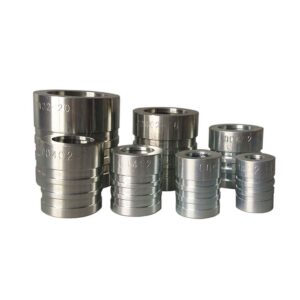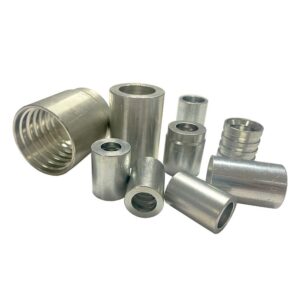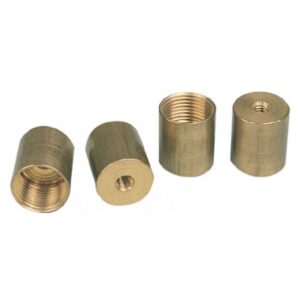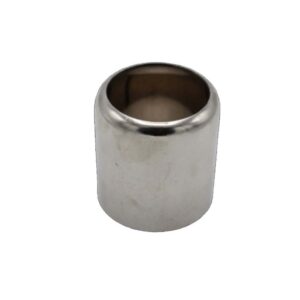Hose ferrules are small but important parts in fluid systems. They connect hoses to pipes, fittings, or equipment. With these connectors, fluid can move safely and smoothly. It helps prevent loose connections and leakage. Because of this, ferrules are widely used in hydraulic systems and many fluid transfer applications in machinery, oilfields, mining, construction, transportation, food processing, and more. Although small, they can handle high pressure, vibration, and harsh working conditions. A good ferrule keeps the hose stable, maintains system pressure, and reduces the risk of damage or downtime.

In this article, we will introduce the functions, types, materials, applications, installation steps, maintenance tips, and buying suggestions for hose ferrules. You will learn everything you need to know about these important fittings.
Structure and Materials of Hose Ferrules
Materials:
The material of a hose ferrule depends on how and where it will be used. Common materials include metals like steel, brass, and aluminum. Some ferrules are made from alloys. Others use plastics such as polyurethane or polypropylene, or rubbers like nitrile rubber and Viton. Choosing the right material makes sure the ferrule has enough strength and can resist corrosion and high temperatures.
Internal Structure:
The inside of a hose ferrule includes an insertion hole and a locking structure. The insertion hole is the place where the hose slides in, and it matches the hose’s outer diameter to create a tight fit. The locking part may be a thread, a clamp, or another design. Its job is to hold the hose in place and make the connection stronger and more secure.

Shape:
Hose ferrules usually have a ring or band shape. Their inner diameter and thickness are set according to the hose size and connection needs. They can come in different cross-section shapes, such as round, oval, square, or even polygonal, to fit different types of connections.
What are ferrule connectors used for?
Hose ferrule are widely used in hydraulic systems, especially in hydraulic systems. They can be used to connect various hydraulic components, including hydraulic pumps, hydraulic motors, hydraulic cylinders, etc. In addition, in other mechanical equipment, sleeve flexible connectors are also commonly used to connect the two ends of rotating shafts.
What are the purposes of a ferrule?
The ferrule is a crucial component that connects the hose and the fitting, forming a leak-proof seal. The ferrule securely clamps the hose using a crimping machine, preventing hydraulic fluid leakage. When hydraulic fluid flows through the hydraulic line, the hydraulic hose is subjected to a certain pressure, and the ferrule prevents leakage and detachment between the hose and the fitting. It is essential for the safe and reliable operation of the entire system.
What are the materials of the hose ferrule?
Hydraulic hose fittings have cylindrical ferrules, which are typically crimped onto the end of the hydraulic hose to securely fasten the hose to the fitting. They are usually made of metal and require a certain degree of pressure resistance and impact resistance. Common materials include carbon steel, stainless steel, and brass; surface treatments include yellow zinc plating, black zinc plating, chromium-free zinc plating, and nickel plating.
Carbon steel ferrules have high hardness, good wear resistance, and durability. Carbon steel maintains a stable shape even under extreme conditions and can withstand greater wear even at high temperatures, high pressures, high speeds, and high loads. It is lightweight and cost-effective, and is commonly used in the mechanical and electronic industries.

Stainless steel ferrules offer excellent corrosion resistance and high-temperature resistance, and have a certain degree of resistance to some chemicals. They are often used in wet or corrosive working environments, such as the chemical and medical industries.

Brass ferrules have lower corrosion resistance and are typically used in low-pressure, non-corrosive environments, especially suitable for light-duty hydraulic systems and pneumatic applications.

Composite ferrules are lightweight and used in speciaized aplications where adaptability and material-specitic advantages are needed. They are oftenemployed in industries that require non-metalitc solutions, such as food processing, pharmaceutical production, and sensitive electronic environments.

Types of hydraulic hose ferrule
Hose ferrules are classified according to the different types of hoses they are suitable for. Correctly selecting hose ferrules is an important requirement for matching hydraulic pipes and ensuring that the hydraulic system does not leak.
Below are several common hydraulic hose ferrule type:
Tapered Ferrules:
Tapered ferrules have an inner bore that becomes narrower toward one end. They work well with tapered couplings. This shape helps create a tight fit and a reliable seal.
Flange Ring:
A flange ring is used for flange-style connections. Its inside shape is usually round or square. It helps seal liquid or gas systems and keeps the flange joint safe and leak-free.
Quick Connector Ferrule:
Quick connector ferrules are made for quick plug-in systems, such as quick couplings and fast pipe connectors. They allow fast installation and removal, making them ideal for use cases that need frequent connection and disconnection.
Hydraulic Rings:
Hydraulic rings are designed for hydraulic systems. They use strong materials and special inner structures that resist high pressure and wear. This keeps the hydraulic connection stable and well-sealed even under heavy load.
Hose Clamp Ferrules:
Hose clamp ferrules are used to add extra support to a hose connection. They wrap around the outside of the hose to increase strength and extend the life of the joint.
How to choose the right ferrule?
When selecting a hose ferrule, the following aspects should be considered based on the actual application:
Working environment: If working in harsh environments such as dampness or corrosion, choose a hose ferrule with rust-proof and corrosion-resistant properties. If the conveyed medium is corrosive chemicals, consider a stainless steel hose fitting. For low-pressure, non-corrosive environments, brass hose ferrules can be used.
Working pressure: Each hose ferrule has specific pressure and temperature limits; exceeding these limits may lead to failure.
درجة حرارة العمل: Hose ferrules are also affected by temperature during use. Exceeding the appropriate temperature range may cause the connector material to crack, melt, or even fail.
In addition to considering external conditions, several factors of the hose ferrule itself also need careful consideration.
مقاس: Size refers to the diameter of the connector. First, determine the size of the bolt or nut and the hose to be connected, and then select a matching connector size.
مادة: Choose the appropriate material based on the frequency of use and working intensity.
طول: Hose ferrules come in different depths. Shallow connectors are suitable for limited spaces, while deep connectors can better accommodate longer bolts.
Finally, you need to choose a professional hydraulic hose ferrule supplier. Typically, their products offer better assurance in terms of materials, manufacturing processes, and precision. Based on your budget, choose the appropriate hose ferrule to meet your needs.
How do I know my ferrule size?
The simplest way to measure the outer diameter (OD) of a ferrule is to use a caliper or a ruler. Place it on the ferrule and measure along its outer profile. You can compare the ferrule with a reference ferrule of known size to determine its dimension. If you don’t have a reference sleeve, you can consult standard size charts.
To measure the inner diameter (ID) of the ferrule, use a caliper or an external measuring tool, such as a vernier caliper or a depth gauge. Place the measuring instrument, identify a starting point, and adjust the position to take measurements at several locations along the ID. Then calculate the average or pick the largest value (depending on your application).
You can also look for markings or numbers on the ferrule to identify its size. These marks are usually on one side of the ferrule or at the bottom. Refer to the ferrule’s specification sheet to understand where the markings are and what they mean. The marking should specify the ferrule’s size, plus any other relevant working information.
If you know specific parameters related to the ferrule — for example, the hose wall thickness or the hose dimensions — you can apply a simple formula to compute the ferrule size. Note, this method assumes that you understand the design principles of the tool and apply it correctly.
No matter which measuring method you use, make sure you apply the correct technique. Repeating the same method helps improve accuracy and eliminate possible errors. Also, it's best to use tools and ferrules that meet recognized industry standards to ensure precise measurements.
How to install a hose ferrule?
Proper installation of the ferrule is crucial to ensuring the sealing performance of the hydraulic hose assembly. A tight and even crimp is an essential method for installing the hose ferrule. Professional crimping tools can easily accomplish this task. We can provide dedicated hydraulic hose crimping machines. Each machine has a corresponding hydraulic hose crimping size range. Simply select the appropriate hose ferrule and machine according to your hydraulic hose. When crimping, be sure to ensure that the ferrule is properly aligned with the hose and fitting before applying pressure. Complete the crimping by pressing the operating button according to the operating instructions. See here for more detailed steps. See here for selecting the appropriate hydraulic hose crimping machine.
Skive vs. Non-Skive hose ferrule
There are two main types of ferrules used in hydraulic hose assemblies: non-skive ferrules and skive ferrules. Non-skive ferrules are designed for hoses that do not require removal of the rubber cover. In this type of assembly, the ferrule is crimped directly over the outer jacket of the hose. This style is widely used on standard braided hoses such as SAE R1AT, R2AT, and EN 853 1SN/2SN, offering reliable performance with simpler preparation.
Skive ferrules, on the other hand, require the removal of part of the hose’s outer rubber layer—or in some cases, both the outer and inner rubber layers. This creates a deeper bite during crimping and offers a stronger mechanical grip. Skive ferrules are typically used for high-pressure or multi-layer spiral hoses, including 4SP, 4SH, R12, and R13, where additional holding strength is needed to withstand extreme working pressures.
Choosing the correct ferrule type is essential, as it must match the hose’s construction to ensure safe, stable, and long-lasting performance.
Precautions for hose ferrules
When using the hose ferrule fittings, you also need to pay attention to the following points:
Several common installation errors can significantly shorten the lifespan of hose fittings and lead to system failure. These errors include: Misalignment: If the fitting is not properly aligned with the hose and connector, uneven pressure distribution during crimping can create weak points at the connection, potentially leading to leaks or failure.
Over-crimping: Applying excessive pressure during crimping can damage the hose or fitting, causing cracks, deformation, or shrinkage, thus impeding fluid flow.
Under-crimping: Insufficient pressure can cause the connection to loosen, and the hose may slip out of the fitting over time or leak under pressure. Avoiding these errors requires strict adherence to the manufacturer's crimping instructions and ensuring the fitting is correctly positioned before starting crimping. Proper training of technicians is also crucial to minimizing these risks.